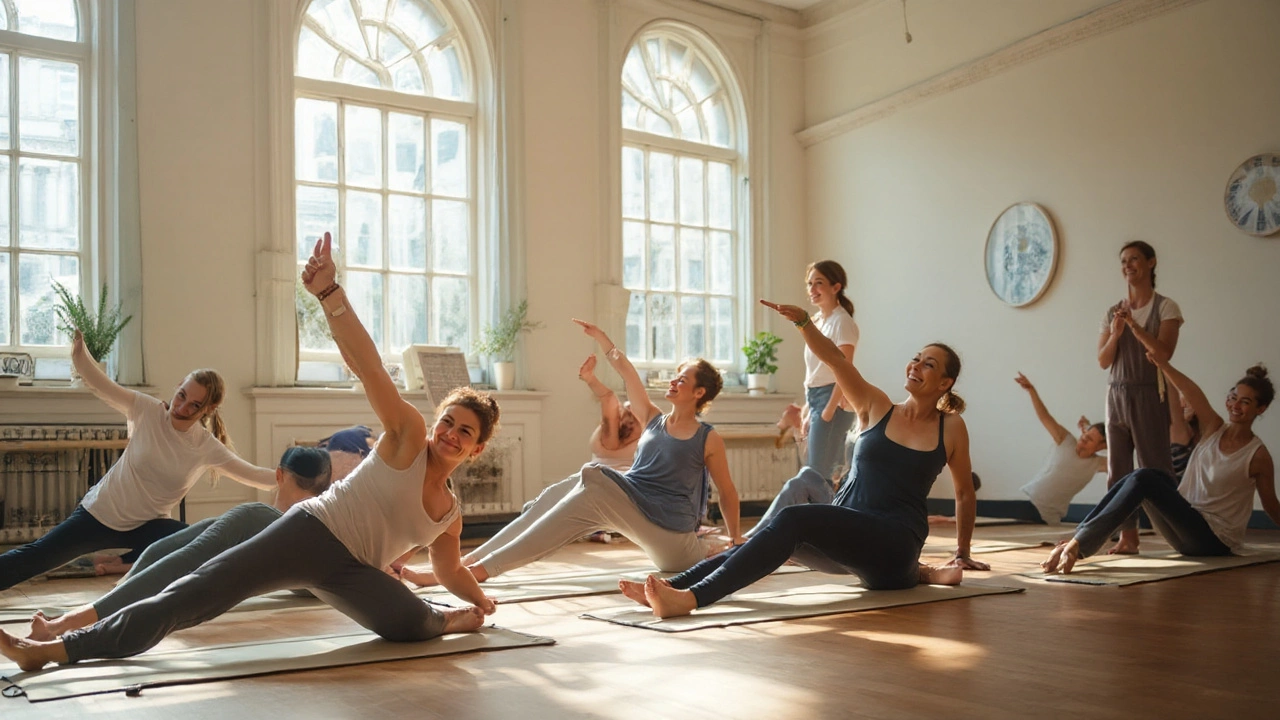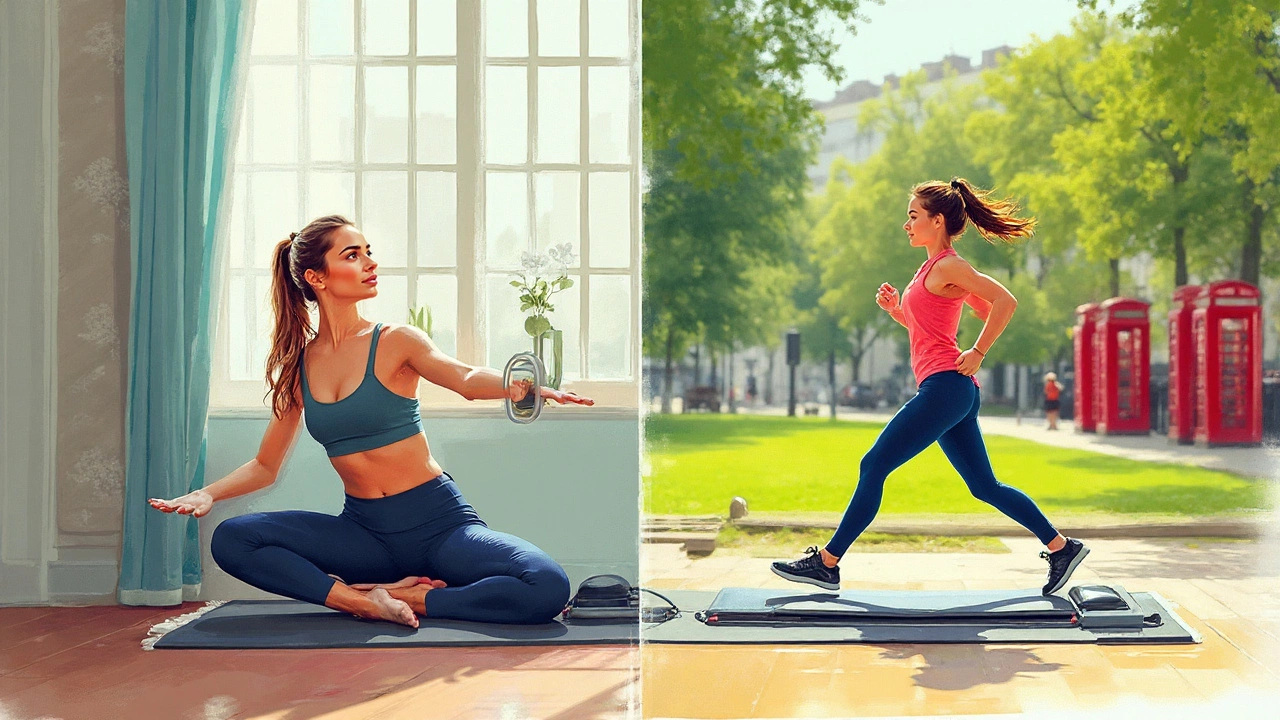
Sneaking a look at social media, you'd think Pilates is the magic solution for every body type—long lean muscles, graceful posture, zero sweat. Some say you barely have to try. But can one style of exercise really be powerful enough to get you truly fit? Maybe it’s the Mat versus Reformer debate, or maybe it’s all those celebrity testimonials. Either way, people want to know: Is Pilates the only thing your body needs to become stronger and healthier, or is that just clever marketing?
What Does ‘Getting Fit’ Really Mean?
Fitness isn’t just about looking tight in leggings or gaining abs. It covers a whole spectrum: strength, cardiovascular health, mobility, endurance, and even mental well-being. So when people ask if you can get fit with only Pilates, we need to nail down what "fit" really means. Most trainers break fitness into a few familiar categories—cardio (can your heart keep up with a brisk walk?), strength (can you lift groceries without a hitch?), flexibility (no shame in touching your toes but still… kinda cool), and body composition (the muscle-fat balance most of us track in changing room mirrors).
Pilates wasn’t invented as a silver-bullet workout. Joseph Pilates created it in the 1920s to help injured dancers recover, focusing on core strength, flexibility, and body alignment. The system’s based on precision, control, and breath—it’s more about intention and quality than big, dramatic moves. While traditional weightlifting has you pushing heavy barbells, a Pilates session has you "powering up" through your core to move arms and legs, all while keeping that magic breath flow. That’s not always sweat-till-you-drop, but it is challenging in its own way.
According to the American Council on Exercise, Pilates will score big improvements in core strength, postural alignment, mobility, and balance. The University of Miami published findings showing that even one hour of moderate mat Pilates can burn 170–250 calories, depending on intensity and your weight. That’s about the same as a brisk walk, for comparison.
Here's the rub: If your definition of fitness is running a marathon, Pilates alone probably won’t cut it. But if you want to walk your dog without back pain and feel strong getting up from the couch, you’re definitely on the right track. "Pilates develops the body uniformly, corrects wrong postures, restores physical vitality, invigorates the mind, and elevates the spirit," Joseph Pilates himself once wrote, and it’s hard to argue with that kind of everyday strength.
How Does Pilates Shape Your Body?
One of the biggest draws? The famous “Pilates body.” You know the look: Lithe arms, strong core, not overly bulky. It’s tempting to chalk this up to flawless genetics or endless hours at the studio, but there’s science behind it.
Pilates routines, especially those using a reformer or resistance bands, challenge multiple muscle groups with every move. Think: planks, hundreds, teasers, and leg circles—all of which target deep stabilizing muscles most folks ignore at the gym. Because you’re always working on lengthening and controlling movements (instead of pumping out short, explosive reps), you’re building strength while keeping muscle balanced and flexible.
That said, Pilates probably won’t bulk you up the way traditional weight training can. The resistance is lower, and you’re relying more on body weight or spring-loaded equipment. But this lower-resistance, higher-rep approach is amazing for muscle endurance, postural strength, and body awareness. You develop that upright posture and “tall” feeling—not by magic, but by training your stabilizers and working the muscles other routines miss.
The special sauce in Pilates isn’t about making you into an Olympic sprinter. It’s about giving you balanced functional strength. There’s a 2018 study in the Journal of Exercise Rehabilitation showing that eight weeks of mat Pilates increased both flexibility and core muscle endurance in healthy adults. Those aren’t small perks: with a stable and strong center, every movement in daily life gets safer and easier.
| Pilates Benefit | Confirmed By Study | Main Area of Impact |
|---|---|---|
| Core Strength | Yes | Abdominals, Lower Back |
| Flexibility | Yes | Hips, Hamstrings, Spine |
| Posture | Yes | Upper Body Alignment |
| Balance | Yes | Stabilizer Muscles |
| Endurance | Partly | Muscle Stamina |
You probably won’t see major changes in muscle mass, but your core will get stronger, and your body will look more streamlined and balanced. The changes might feel subtle at first, but they build over time—kind of like a slow-growing confidence from the inside out.

Pilates for Cardio, Strength, or Both?
Let’s get real about heart health. Most Pilates classes won’t get your heart racing the way jumping jacks or running up stairs can. If weight loss or cardio endurance is your goal, classic Cardio Pilates or vigorous contemporary classes are your best bet. (Yes, there are fusion classes for almost every taste now—Mat Pilates with HIIT intervals, anyone?)
According to a Harvard Medical School review, an average 155-pound person will burn about 175 calories in 30 minutes of beginner Pilates. Intermediate or advanced levels jump this to around 250+ calories. For reference, jogging at 5mph burns about 300 calories in the same time. So, Pilates is steady but not a wild calorie-torcher.
Pilates shines for muscle endurance, core engagement, and postural awareness—but for maximum fitness, most instructors recommend pairing Pilates with traditional cardio. Walking, cycling, or swimming just twice a week amps up your heart health while Pilates does the magic for core and stability. Remember, the American Heart Association suggests at least 150 minutes of moderate aerobic activity weekly. Pilates makes a solid foundation, but mixing things up helps your heart and keeps boredom far away.
Now, about strength: Pilates uses body weight, resistance bands, or machines, but it doesn’t measure up to the hypertrophy (muscle-building) of heavy weights. So, if deadlifting double your body weight is on your bingo card, Pilates alone won’t get you there. Still, a lot of everyday strength depends on stabilizer muscles and core engagement—precisely what Pilates trains best. If you sit most of the day or struggle with back pain after carrying groceries, this kind of strength is invaluable.
"I’ve seen clients gain lean muscle definition, better posture, and new levels of body confidence from Pilates alone—but for all-out fitness, I always recommend sprinkling in a little cardio and resistance work too," says Lisa Hubbard, a renowned Pilates educator. "Pilates is transformative, but a balanced routine covers all bases."
The Mental Edge: Pilates for Mind-Body Fitness
If motivation is a struggle, Pilates serves up something special—mindful movement. Every session has you focusing on breath, precision, and sensory feedback. This conscious connection (sometimes called the “Pilates Principle of Centering”) isn’t just new-age talk. According to a study from Princeton Neuroscience Institute, activities that sync physical movement with mindful focus visibly sharpen brain activity and mental resilience.
You end classes feeling not just looser physically but lighter mentally. Plenty of people report reduced anxiety and improved mood, especially after stressful weeks. Pilates is often used in rehab for its “neuromuscular rewiring”—basically retraining the connection between mind and muscle, so you move with intention instead of autopilot. This is why Pilates is a favorite for athletes coming back from injury or for folks with long-term back pain. It’s not just about strength; it’s about teaching your brain and body to coordinate smarter, safer movements in everything you do.
Pilates also has roots in stress relief. The rhythmic breathing (inhale, exhale…), the repeated cues to “draw your shoulders back,” and the simple, controlled exercises all pull you out of future worries or ruminative thoughts. Whether you’re on the mat at home or in a class, the effect is almost meditative—and, let’s be honest, we could all use a bit more focus and calm these days.
Maybe that’s why Pilates regularly lands on lists for best exercises to boost mental health. It works differently than high-intensity workouts: less adrenaline, more endorphins and dopamine (the feel-good chemicals), plus a sweet drop in cortisol (the stress hormone). Over time, this combination can improve sleep, sharpen memory, and kickstart sharper decision-making—useful perks in or outside the gym.

Practical Tips: Maximizing Results from Pilates
If you want to see true transformation with Pilates, the magic is in consistency and variety. Experts say aiming for at least three 45–60-minute sessions per week provides enough stimulus for meaningful change. If you’re already active, try mixing Pilates with running, swimming, cycling, or resistance training for faster, more balanced progress.
Here’s how to nail your Pilates practice and stay motivated:
- Pilates loves variety. Alternate between mat and equipment-based workouts to challenge different muscles and keep boredom at bay.
- Don’t ignore tempo. Super slow, controlled moves are where the deep stabilizers wake up. Rushing through routines cheats you of the biggest benefits.
- Try group classes, private lessons, or streaming platforms until you find a teacher that resonates. Sometimes the right cue makes everything click.
- If you hit a plateau, blend in contemporary Pilates or fusion classes paired with body weight circuits or light dumbbells.
- Track your progress. Small wins—better posture, less back pain, increased mobility—add up fast. Take photos, jot down milestones, and actually celebrate improvements.
The secret sauce to making Pilates work for you? Don’t just rely on how you look in the mirror. Tune into how you feel: stronger, taller, more limber. In the end, fitness isn’t just an aesthetic; it’s the confidence to move through your day with ease. If Pilates alone feels right for your body, keep at it. If you crave more sweat or power, sprinkle in some cardio or resistance training. Fitness isn’t “one size fits all”—but with Pilates, you’ll always build a foundation that lets you try anything else, too.
